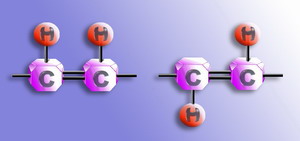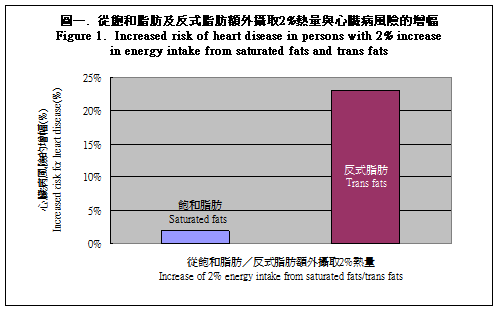
Food Safety Focus (16th Issue, November 2007) – Incident in Focus
Trans Fats in Foods
Reported by Ms. Melissa LIU, Scientific Officer,
Risk Assessment Section, Centre for Food Safety
Background
In response to increasing health concern over trans fats in food internationally and locally, the Centre for Food Safety (CFS) and the Consumer Council conducted a joint study on trans fats in foods in Hong Kong to test the levels of trans fats in foods available in the local market and to enhance consumer understanding on trans fats and their health implications. The results of the study were announced on 15 October and published in the October issue of CHOICE magazine.
A total of 80 prepackaged and non-prepackaged food products, including bakery products, deep fried foods, butter and margarine/margarine-like spreads, were collected for testing. The study found that the trans fats levels varied a lot among same kind of food, whereas some of the products tested, such as cream-filled bread with shredded coconut, contained high levels of trans fats.
Illustration: Cream-filled bread with shredded coconut

What are Trans Fats?
Trans fats, also called trans fatty acids, are a type of unsaturated fats. They are mainly formed during the process of hydrogenation of vegetable oils. During hydrogenation, the structure of the fatty acid molecules in the oil changes, which allows the hydrogenated oil to have longer shelf-life and provide desirable texture to the food it produces. These fatty acids with changed structure are known as "trans fats".
Illustration: Molecular structures of unsaturated fatty acids
Left: cis-unsaturated fatty acid (carbon atoms joined by a double bond, cis-configuration). Right: Trans-unsaturated fatty acid (carbon atoms joined by a double bond, trans-configuration).

What Food may Contain Trans Fats?
Hydrogenated vegetable oils, such as some shortening and margarines produced by hydrogenation, are usually high in trans fats. Trans fats in our diet mainly come from fried and bakery products with hydrogenated vegetable oil. Trans fats are also present naturally in milk and fats of sheep and cattle, such as whole milk and butter, but only at low levels.
Examples of foods that may be produced with hydrogenated vegetable oil:
- Crackers
- Chips
- Cakes
- Salad dressings
- Pastries
- Dried/powdered non-dairy creamers
- Bread
- Fried products such as French fries
What are the Health Concerns Regarding Trans Fats in Food?
Trans fats increase the level of low density lipoprotein (LDL) cholesterol, the harmful cholesterol, while at the same time reduce the level of high density lipoprotein (HDL) cholesterol, the beneficial cholesterol. This increases the risk of heart disease, which is the second major killer in Hong Kong . The World Health Organization and the Food and Agriculture Organization of the United Nations suggest that diets should provide a very low intake of trans fatty acids. In practice, less than 1% of daily energy intake should be from trans fats1 . For example, an individual with a daily energy intake of 2000 kilocalories should limit the intake of trans fats to less than 2.2 grams per day.
What are the Differences Between Trans Fats and Saturated Fats?
Saturated fats, also known as saturated fatty acids, are abundant in animal fats such as butter and lard, as well as some vegetable oils such as coconut oil. As they are in solid state at room temperature, they can be easily recognised. Similar to trans fats, saturated fats also increase the level of LDL cholesterol. However, unlike trans fats, they do not reduce the level of HDL cholesterol.
Trans fats intake varies in different countries. It ranges from 0.6% of total energy intake in the Australian population, to 2.6% daily energy intake in the American population. Studies showed that an extra intake of 2% energy from trans fats (e.g., about 4.4 g extra trans fats intake for an individual with 2000 kcal daily energy intake) led to an increase of 23% of risk of heart disease, but if the same level of extra energy was from saturated fats instead, the risk of heart disease only increased by 2% 2 ,3 (Figure 1). Therefore, trans fats are believed to be more harmful to health than saturated fats.
Since both saturated fats and trans fats can increase the risk of heart disease, it is healthier to choose food low in both saturated and trans fats.
Are Alternative Fats and Oils Available?
Our study found that trans fats levels varied a lot among same kind of food. Such results indicate that it is practically possible to reduce trans fats level in food. Hydrogenated fats and oils may be replaced by those oils high in monounsaturated (e.g. canola oil and olive oil) and polyunsaturated fats (e.g. soybean oil , corn oil and sunflower seed oil), which are beneficial to health if taken in appropriate amount.
Advice to the Trade and Public
The public should maintain a balanced diet and avoid deep-fried and fatty foods. They should also read food labels, avoid foods produced with hydrogenated oils or fats, and choose food that have lower fat contents (including saturated fats and trans fats).
The trade is advised to reduce trans fats level in food products by avoiding the use of hydrogenated vegetable oil. The ingredients used should be clearly declared for prepackaged food and should not be misleading so that consumers can make informed choices of their food.
1 WHO. Diet, nutrition and prevention of chronic diseases. Report of a Joint WHO/FAO Expert Consultation. WHO Technical Report 916. World Health Organization, Geneva 2003.
2 Mozaffarian D, Katan M, Ascherio A, Stampfer M, Willett W. Trans fatty acids and cardiovascular disease. NEJM 2006. 354; 15: 1601-1613.
3 Sampfer MF, Sacks FM, Salvini S, Willett WC, Hennekens CH. A prospective study of cholesterol, apolipoproteins, and the risk of myocardial infarction. NEJM 1991; 325; 6: 373-381.


